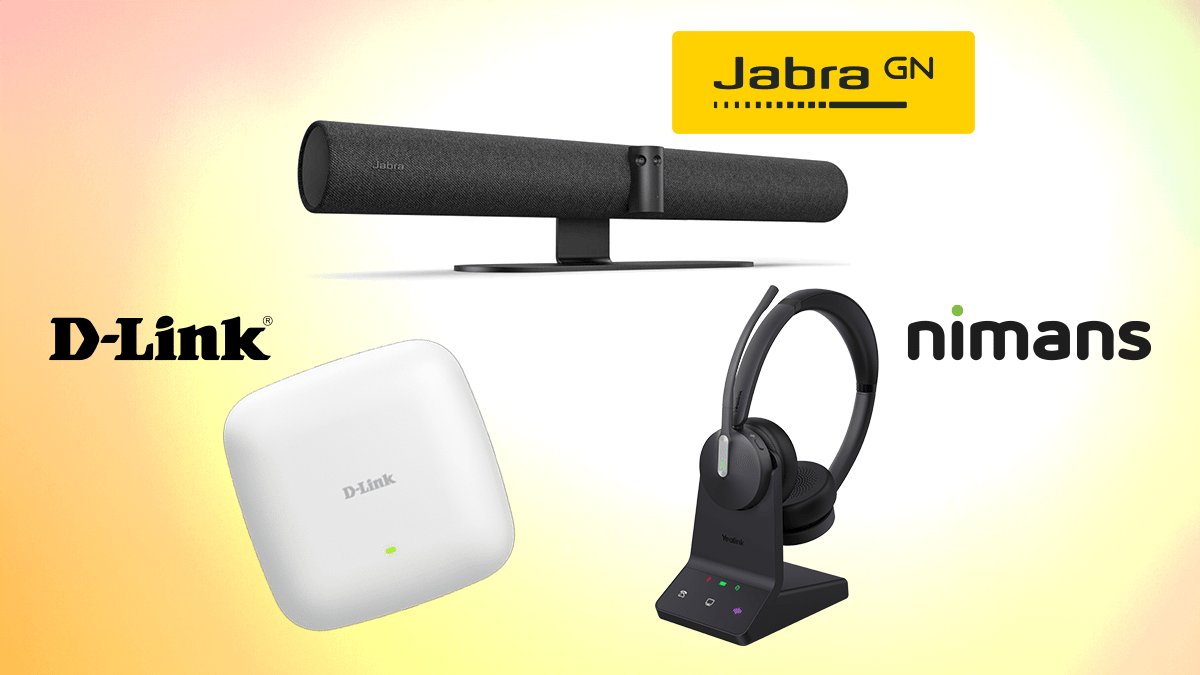All too often small and medium sized businesses (SMBs) buy UC&C products that are not designed for business needs, such as phones, routers and headsets. Savings on the costs are offset by poor functionality, multiple re-purchases and the wrath of disgruntled employees.
The number of private sector businesses in the UK at the start of 2023 was 5.6 million*, according to the estimates produced by the Department for Business and Trade (DBT), with 5.51 million of those businesses considered small (0 to 49 employees) and 36,900 businesses classified as medium-sized (50 to 249 employees). Compared with 2022, the private sector business population has increased by 0.8% (that’s an extra 46,000 businesses). However one carves the data the fact remains, the UK SMB sector is substantial, growing and assumedly industrious.
SMBs need communication devices to collaborate with customers and suppliers, and whether their workspace is a home office, a back office or rented office space, to name only a few of the variations of workspaces that exist out there, they all need those essential devices that help them run smoothly.
UC Advanced caught up with three managers from Nimans, D-Link and Jabra, who have seen quite a few SMBs purchasing devices for business purposes in their lifetimes, and enquired about whether they had any sage advice for all SMBs considering their next device for their company. Alan Jones, Marketing Manager at D-Link focused on Access Points, those all important devices that connect wireless devices to a wired network, often called internet or wireless routers. Paul Burn, Managing Director at Nimans, focused on headphones, much needed when you are sharing premium office space, operating a busy customer line or constantly walking between an office and a warehouse. Nigel Dunn, Managing Director EMEA North, Jabra concentrated on videobars, a rapidly growing sector as SMBs look to redesign and equip meeting spaces with all-in-one solutions.
Universally, all three experts agreed that SMBs purchasing devices for their businesses should be considering performance, durability, functionality, warranties, energy efficiency and reseller customer service.
Purposefully Purchasing D-Link Access Points
Alan Jones from D-Link discussed the hidden costs of cutting corners and why SMBs should invest in business-grade access points, stating, “Small and medium-sized businesses (SMBs) should always be looking for that edge, and any angle they can exploit, to reduce costs while maintaining high levels of productivity and efficiency, especially at the moment with low levels of economic growth on the horizon.. It’s understandable – every penny saved can have a significant impact on the bottom line. However, one area where cutting costs can backfire is in the IT infrastructure, particularly when it comes to network devices like Access Points (APs).”
The Temptation of Consumer-Grade Equipment
It’s a scenario we’ve seen time and time again: a small business opts for cheaper, consumer-grade APs designed for home use, thinking they will perform just as well in a business setting. On paper, it might seem like a smart decision. After all, why not save money by purchasing a device that seemingly offers the same basic functionality? Unfortunately, this short-term saving can lead to long-term headaches.
Consumer-grade APs are built for light, intermittent use. They’re perfect for homes where only a handful of devices connect to the internet simultaneously. However, these devices simply aren’t equipped to handle the rigorous demands of a business environment, where multiple devices need to be connected 24/7, and where the network is the backbone of daily operations.
The Real Difference: Performance and Durability
One of the most significant differences between consumer-grade and business-grade APs is their performance and durability. Business-grade APs, like those offered by D-Link, are specifically designed to handle the high traffic loads that are typical in an SMB setting. They offer robust features such as:
1 Advanced Security Features: Business APs come with enhanced security protocols, including WPA3 encryption, VLAN support, and intrusion detection systems. These features are crucial for protecting sensitive business data from cyber threats – a growing concern for SMBs as cyber-attacks become more sophisticated.
2 Scalability: As your business grows, so will your network needs. Business-grade APs are designed to scale, allowing you to easily add more APs to your network without a drop in performance. Consumer-grade APs, on the other hand, can quickly become overwhelmed as the number of connected devices increases.
3 Optimised for High-Density Environments: In a typical office, you have dozens of devices—computers, smartphones, tablets, and IoT devices—all competing for bandwidth. Business APs are optimized for these high-density environments, ensuring that all devices get a strong, stable connection without bottlenecks.
4 Longer Lifespan: Business-grade APs are built to last. They’re designed with high-quality components that can withstand the rigors of continuous use in a busy office environment. While the initial investment might be higher, the longer lifespan of these devices means they often end up being more cost-effective in the long run.
5 Advanced Management and Monitoring: Business APs offer sophisticated management tools that allow IT administrators to monitor network performance in real-time, make adjustments on the fly, and troubleshoot issues before they impact productivity. Consumer-grade devices often lack these advanced management capabilities, making them less reliable in a business setting.
The Hidden Costs of Consumer-Grade APs
While consumer-grade APs might seem like a bargain initially, the hidden costs can quickly add up. Frequent breakdowns, poor performance, security vulnerabilities, and the need for constant replacements can end up costing a business much more than the price difference between consumer and business-grade devices.
Moreover, the downtime caused by unreliable network equipment can lead to lost productivity, frustrated employees, and unhappy customers. In today’s connected world, where so much of business depends on seamless internet access, these are costs that no SMB can afford to bear.
Making the Smart Investment
At D-Link, we understand the unique challenges faced by SMBs, and our business-grade APs are designed to meet those challenges head-on, such as the DAP-X3060. By investing in equipment that is built for the demands of a business environment, SMBs can ensure that their network remains a reliable foundation for growth.
In the end, it’s about understanding the value of quality and reliability. While consumer-grade APs might save money upfront, they often fall short when it comes to delivering the performance, security, and durability that a business needs. Investing in business-grade equipment is not just about spending more—it’s about ensuring your business has the tools it needs to succeed.
So before you opt for the cheaper option, consider the true cost of your decision. When it comes to your business network, cutting corners on equipment can cut deep into your bottom line. Choose wisely, invest in quality, and ensure your network is as robust as your ambitions.
Purposefully Purchasing Headphones from Nimans
In today’s competitive business landscape, UK SMB’s must prioritise effective communication to maintain professionalism and efficiency. While consumer headphones designed for domestic use may appear to be an attractive, cost-effective solution, they are not ideally suited for professional environments with significantly higher demands and expectations. Here are several reasons why small businesses should invest in professional-grade headsets rather than relying on consumer models.
Superior Audio Quality
Clear and accurate audio is critical in professional communications, especially when interacting with clients, conducting virtual meetings, or coordinating with team members. Consumer headphones might deliver acceptable sound quality for personal use, but they often fall short when it comes to the clarity and fidelity needed for business communications. Professional headphones are designed to offer superior sound quality, with features like enhanced noise cancellation that block out ambient noise, ensuring that voices are heard clearly on both ends of a conversation. This is particularly important in open office environments or when working remotely in less controlled environments.
Comfort for Extended Use
In a professional setting, employees may wear headphones for several hours each day. Consumer headphones, while adequate for short periods, often lack the ergonomic design needed to ensure comfort during extended use. Poorly designed headphones can lead to discomfort, headaches, and even long-term health issues, which can negatively impact productivity. Professional-grade headphones are specifically designed to provide a comfortable fit, with adjustable headbands, cushioned ear cups, and lightweight materials that minimise pressure on the head and ears. This attention to comfort ensures that employees can focus on their work without being distracted by discomfort or the need to frequently remove their headphones.
Reliable Connectivity
In business communications, reliable connectivity is crucial. Consumer headphones, particularly wireless models, can suffer from connectivity issues such as dropped signals or interference, which can disrupt important calls or meetings. Professional headphones, on the other hand, often come with more stable and reliable connectivity options, whether through wired connections that eliminate the risk of interference or advanced wireless technologies that ensure a consistent signal. This reliability is essential for maintaining smooth communication and avoiding the frustration and potential embarrassment of technical difficulties during critical interactions.
Seamless Integration with Professional Systems
Small businesses often rely on specific communication platforms and software, such as VoIP systems, video conferencing tools, and customer service applications. Consumer headphones may not always be compatible with these systems, leading to connectivity issues, poor audio quality, or limited functionality. Professional headphones, however, are designed with business use in mind and often include features that allow for seamless integration with a wide range of professional communication systems. This ensures that businesses can leverage their technology to its fullest potential without being hindered by equipment limitations.
Durability and Longevity
Consumer headphones are typically built with casual use in mind—listening to music, watching videos, or making occasional phone calls. As a result, they often lack the robust construction required to endure the daily wear and tear of a busy work environment. In contrast, professional headphones are engineered for continuous use. They are made from higher-quality materials that can withstand the rigours of a professional setting, including extended periods of use and frequent handling. Investing in professional-grade equipment can save businesses money in the long run by reducing the need for frequent replacements due to breakage or wear.
Comprehensive Warranty and Support
When using equipment in a professional setting, having access to reliable warranty coverage and technical support is invaluable. Consumer headphones typically come with limited warranties and minimal support, which can be problematic if an issue arises. Professional-grade headphones, however, often include comprehensive warranties and dedicated customer support services, offering peace of mind and ensuring that any issues can be resolved quickly and efficiently, minimising downtime and disruption to business operations.
While consumer headphones may seem like a convenient and cost-effective choice for UK SMB’s, they are not designed to meet the demands of a professional environment. Investing in professional-grade headphones is a strategic decision that can enhance the quality of communication, improve employee comfort and productivity, and ensure reliable performance in business-critical situations. By choosing equipment that is specifically designed for the job, businesses can foster a more professional image, avoid potential technical issues, and ultimately create a more efficient and effective communication infrastructure.
Purposefully Purchasing Jabra Videobars
Are SMBs put off by business level products with too many features?
SMBs are often deterred by products with too many features that are deemed as too complex and difficult to manage, particularly because typically, they have limited time and resources. We know that businesses want simplicity and ease and of use. Nearly a third (31%) of employees say they are hesitant to take meetings from a meeting room because they aren’t comfortable with the technology, Jabra’s research shows. Overly feature-rich products can overwhelm users, leading to frustration and lower adoption rates. They may also perceive these products as offering poor value if the features seem irrelevant to their requirements and the benefits aren’t clear. This also leads to concerns about wasting budgets on capabilities they won’t use.
Hybrid working/remote working – where do you see the market moving?
We are seeing a return to the office but hybrid working remains the dominant trend. Our research shows that 80% of all meetings include at least one remote participant. As a result, there is demand for Unified Communications (UC) technology that offers the flexibility to work from anywhere, whether at home, in the office or on the move.
As businesses continue to navigate hybrid working, they need to assess how office space is being used and whether the design, layout and meeting room equipment meets their needs.
There is growing demand for adaptable, office workspaces for different requirements —be it collaborative zones, social spaces or quiet areas for focused work. When it comes to rethinking meeting room setups, businesses are looking for reliable, flexible solutions. The emphasis should be on creating the best meeting experience for all participants, whether in the room or joining remotely, where everyone can contribute on an equal footing. These factors will continue to shape the direction of the market.
What advice do you have for SMBs investing in UCC products for business needs?
SMBs should start by reviewing current needs and future growth plans. Do existing products and meeting rooms meet requirements, and if not why?
Look for products that are certified for use with chosen platforms such as Microsoft Teams and Zoom. It’s important to choose solutions that seamlessly integrate with existing tools and platforms and ensure a smooth transition.
Also review how meeting rooms are being used. What’s the main purpose of the room, is it being used to full capacity, is space being optimised, can everyone in the room be seen and heard and have a high-quality meeting experience? Businesses can then look at what the challenges and limitations are of their current products, and identify the solutions that will meet their needs.
Implementing change and installing new products can be daunting but it doesn’t have to be hard. Not all new technology is complex and difficult to use.
When it comes to video conferencing, choose products with plug-and-play functionality. Jabra’s video conferencing solutions are quick and simple to set up and easy to use. The Jabra PanaCast 50 video bar is plug-and-play so users can just walk into a meeting room, plug the cable into a laptop and be up and running on a video call in no time.
Advice to resellers/MSPs selling to SMBs on future-proofing?
It’s important to show SMBs that they can invest in products that can grow with their business. Customers want reassurance that products are built to last and won’t become quickly outdated by a newer version. SMBs should look at making smart long-term investments. For example, Jabra’s PanaCast 50 video conferencing solutions continue to offer new features and improved functionality over time with firmware updates, so they continue to deliver value now and in the future, and adapt with changing needs.
The Jabra PanaCast 50: ideal for SMBs
When it comes to video conferencing, we recognise the importance of having easy-to-use solutions in meeting rooms. It’s also about having flexibility and choice, and there are a range of options across the Jabra PanaCast 50 portfolio.
The Jabra PanaCast 50 for small and medium rooms has a unique 180 degree field-of-view that covers the whole room so that everyone can be seen and heard. This plug-and-play device is easy to set up and use. For those who want a complete room solution, the Jabra PanaCast 50 Room System for Microsoft Teams or Zoom is also a reliable option. This delivers a seamless, plug-and-play experience and comes with the Jabra PanaCast 50 and Lenovo ThinkSmart Core Kit, which includes a touch display for controlling meetings.
Jabra’s PanaCast 50 Video Bar System is an Android collaboration bar that provides all the benefits of the award-winning PanaCast 50. Easy to use, manage and install, it comes with a compute unit and touch controller to manage the room experience, with no need for a laptop or additional devices. Users can simply walk into a meeting room and get going at the touch of a button.
*https://www.gov.uk/government/statistics/business-population-estimates-2023/business-population-estimates-for-the-uk-and-regions-2023-statistical-release











